Analysis of Apple's Business Information System: A Detailed Report
VerifiedAdded on 2020/06/04
|19
|3920
|83
Report
AI Summary
This report provides a detailed analysis of Apple's Business Information System (BIS). It begins with an introduction and scenario description of Apple's business operations, followed by an overview of BIS methods, including Operation Information System (OIS) and Management Information System (MIS), and the rationale for choosing MIS. The report then explores the System Development Life Cycle (SDLC) models, specifically the Waterfall model, and its impact on BIS development. A feasibility study is conducted, covering the executive summary, scope, background, proposed BIS, evaluation, and schedule. Requirement analysis includes stakeholder analysis, need elicitation, requirement prioritization, Entity Relationship Diagrams (ERD), and Data Flow Diagrams (DFD). The report concludes with a summary of findings and references.
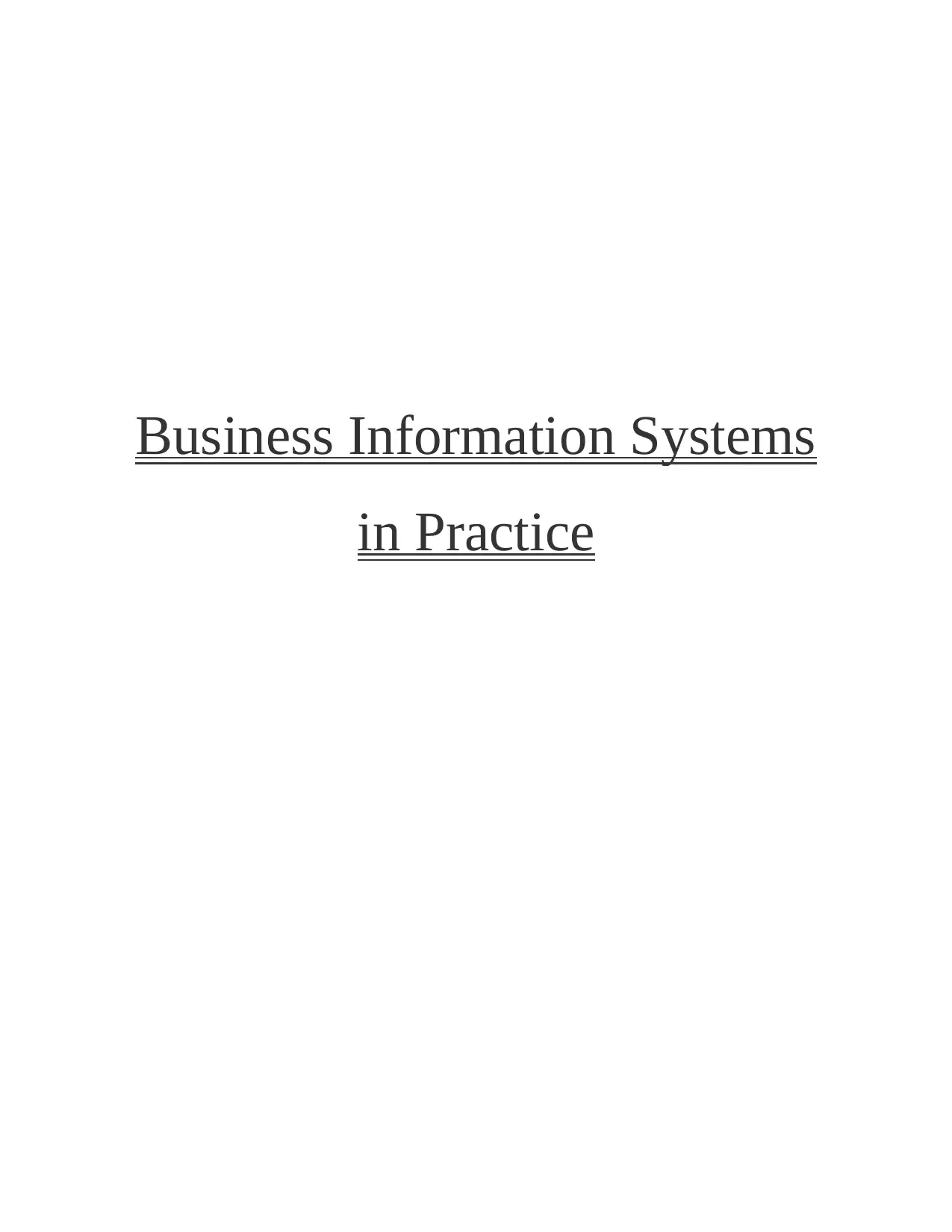
Business Information Systems
in Practice
in Practice
Paraphrase This Document
Need a fresh take? Get an instant paraphrase of this document with our AI Paraphraser
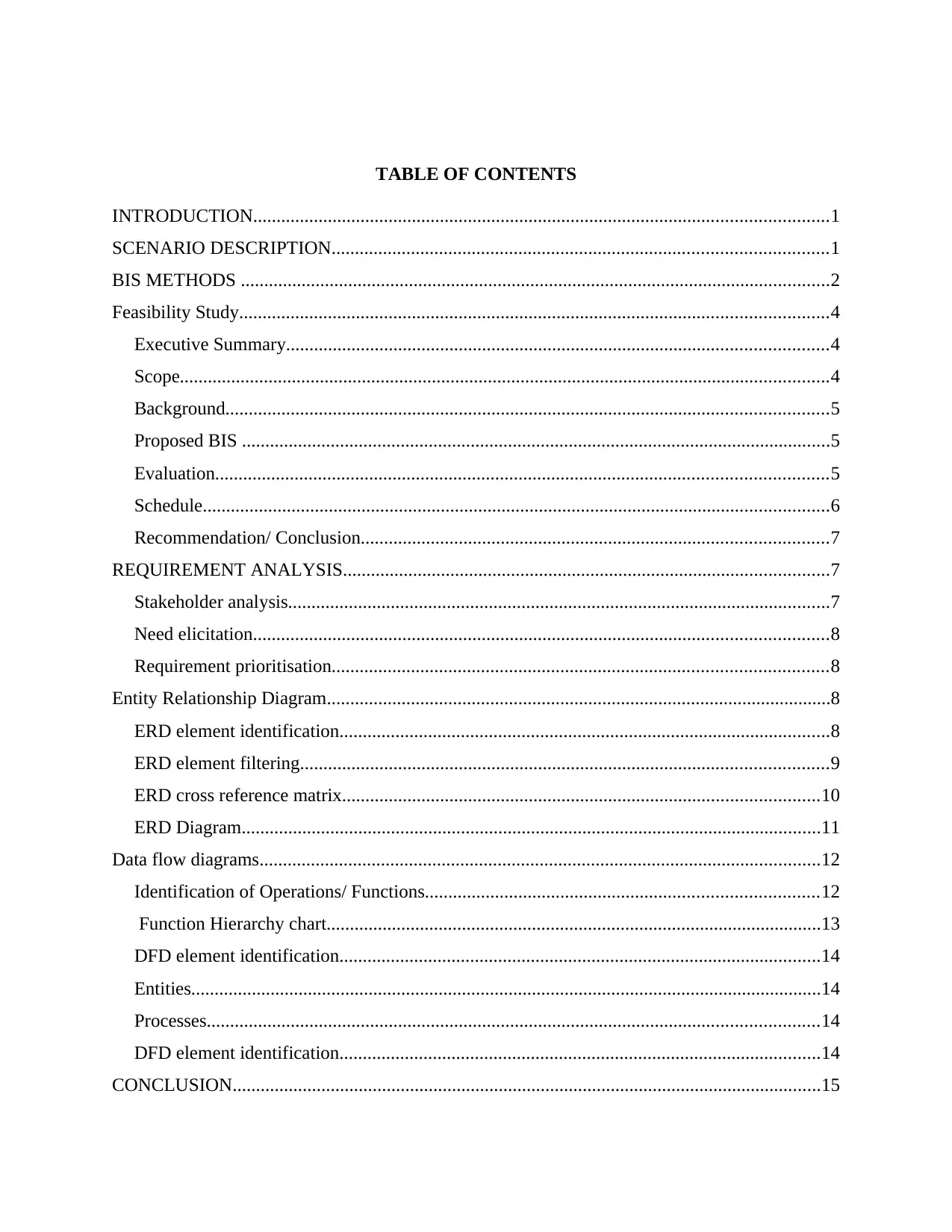
TABLE OF CONTENTS
INTRODUCTION...........................................................................................................................1
SCENARIO DESCRIPTION..........................................................................................................1
BIS METHODS ..............................................................................................................................2
Feasibility Study..............................................................................................................................4
Executive Summary....................................................................................................................4
Scope...........................................................................................................................................4
Background.................................................................................................................................5
Proposed BIS ..............................................................................................................................5
Evaluation...................................................................................................................................5
Schedule......................................................................................................................................6
Recommendation/ Conclusion....................................................................................................7
REQUIREMENT ANALYSIS........................................................................................................7
Stakeholder analysis....................................................................................................................7
Need elicitation...........................................................................................................................8
Requirement prioritisation..........................................................................................................8
Entity Relationship Diagram............................................................................................................8
ERD element identification.........................................................................................................8
ERD element filtering.................................................................................................................9
ERD cross reference matrix......................................................................................................10
ERD Diagram............................................................................................................................11
Data flow diagrams........................................................................................................................12
Identification of Operations/ Functions....................................................................................12
Function Hierarchy chart..........................................................................................................13
DFD element identification.......................................................................................................14
Entities.......................................................................................................................................14
Processes...................................................................................................................................14
DFD element identification.......................................................................................................14
CONCLUSION..............................................................................................................................15
INTRODUCTION...........................................................................................................................1
SCENARIO DESCRIPTION..........................................................................................................1
BIS METHODS ..............................................................................................................................2
Feasibility Study..............................................................................................................................4
Executive Summary....................................................................................................................4
Scope...........................................................................................................................................4
Background.................................................................................................................................5
Proposed BIS ..............................................................................................................................5
Evaluation...................................................................................................................................5
Schedule......................................................................................................................................6
Recommendation/ Conclusion....................................................................................................7
REQUIREMENT ANALYSIS........................................................................................................7
Stakeholder analysis....................................................................................................................7
Need elicitation...........................................................................................................................8
Requirement prioritisation..........................................................................................................8
Entity Relationship Diagram............................................................................................................8
ERD element identification.........................................................................................................8
ERD element filtering.................................................................................................................9
ERD cross reference matrix......................................................................................................10
ERD Diagram............................................................................................................................11
Data flow diagrams........................................................................................................................12
Identification of Operations/ Functions....................................................................................12
Function Hierarchy chart..........................................................................................................13
DFD element identification.......................................................................................................14
Entities.......................................................................................................................................14
Processes...................................................................................................................................14
DFD element identification.......................................................................................................14
CONCLUSION..............................................................................................................................15

REFERENCES..............................................................................................................................16
You're viewing a preview
Unlock full access by subscribing today!
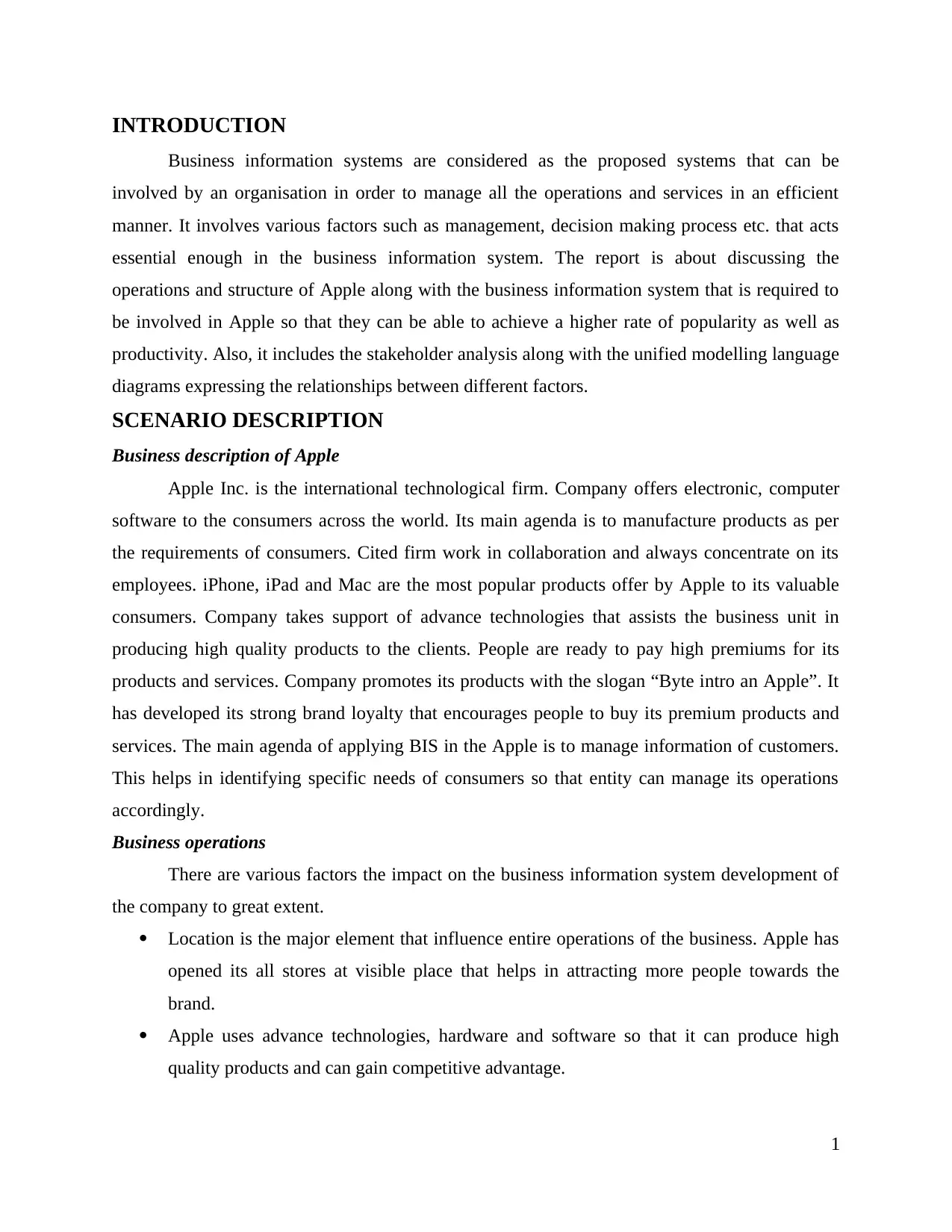
INTRODUCTION
Business information systems are considered as the proposed systems that can be
involved by an organisation in order to manage all the operations and services in an efficient
manner. It involves various factors such as management, decision making process etc. that acts
essential enough in the business information system. The report is about discussing the
operations and structure of Apple along with the business information system that is required to
be involved in Apple so that they can be able to achieve a higher rate of popularity as well as
productivity. Also, it includes the stakeholder analysis along with the unified modelling language
diagrams expressing the relationships between different factors.
SCENARIO DESCRIPTION
Business description of Apple
Apple Inc. is the international technological firm. Company offers electronic, computer
software to the consumers across the world. Its main agenda is to manufacture products as per
the requirements of consumers. Cited firm work in collaboration and always concentrate on its
employees. iPhone, iPad and Mac are the most popular products offer by Apple to its valuable
consumers. Company takes support of advance technologies that assists the business unit in
producing high quality products to the clients. People are ready to pay high premiums for its
products and services. Company promotes its products with the slogan “Byte intro an Apple”. It
has developed its strong brand loyalty that encourages people to buy its premium products and
services. The main agenda of applying BIS in the Apple is to manage information of customers.
This helps in identifying specific needs of consumers so that entity can manage its operations
accordingly.
Business operations
There are various factors the impact on the business information system development of
the company to great extent.
Location is the major element that influence entire operations of the business. Apple has
opened its all stores at visible place that helps in attracting more people towards the
brand.
Apple uses advance technologies, hardware and software so that it can produce high
quality products and can gain competitive advantage.
1
Business information systems are considered as the proposed systems that can be
involved by an organisation in order to manage all the operations and services in an efficient
manner. It involves various factors such as management, decision making process etc. that acts
essential enough in the business information system. The report is about discussing the
operations and structure of Apple along with the business information system that is required to
be involved in Apple so that they can be able to achieve a higher rate of popularity as well as
productivity. Also, it includes the stakeholder analysis along with the unified modelling language
diagrams expressing the relationships between different factors.
SCENARIO DESCRIPTION
Business description of Apple
Apple Inc. is the international technological firm. Company offers electronic, computer
software to the consumers across the world. Its main agenda is to manufacture products as per
the requirements of consumers. Cited firm work in collaboration and always concentrate on its
employees. iPhone, iPad and Mac are the most popular products offer by Apple to its valuable
consumers. Company takes support of advance technologies that assists the business unit in
producing high quality products to the clients. People are ready to pay high premiums for its
products and services. Company promotes its products with the slogan “Byte intro an Apple”. It
has developed its strong brand loyalty that encourages people to buy its premium products and
services. The main agenda of applying BIS in the Apple is to manage information of customers.
This helps in identifying specific needs of consumers so that entity can manage its operations
accordingly.
Business operations
There are various factors the impact on the business information system development of
the company to great extent.
Location is the major element that influence entire operations of the business. Apple has
opened its all stores at visible place that helps in attracting more people towards the
brand.
Apple uses advance technologies, hardware and software so that it can produce high
quality products and can gain competitive advantage.
1
Paraphrase This Document
Need a fresh take? Get an instant paraphrase of this document with our AI Paraphraser
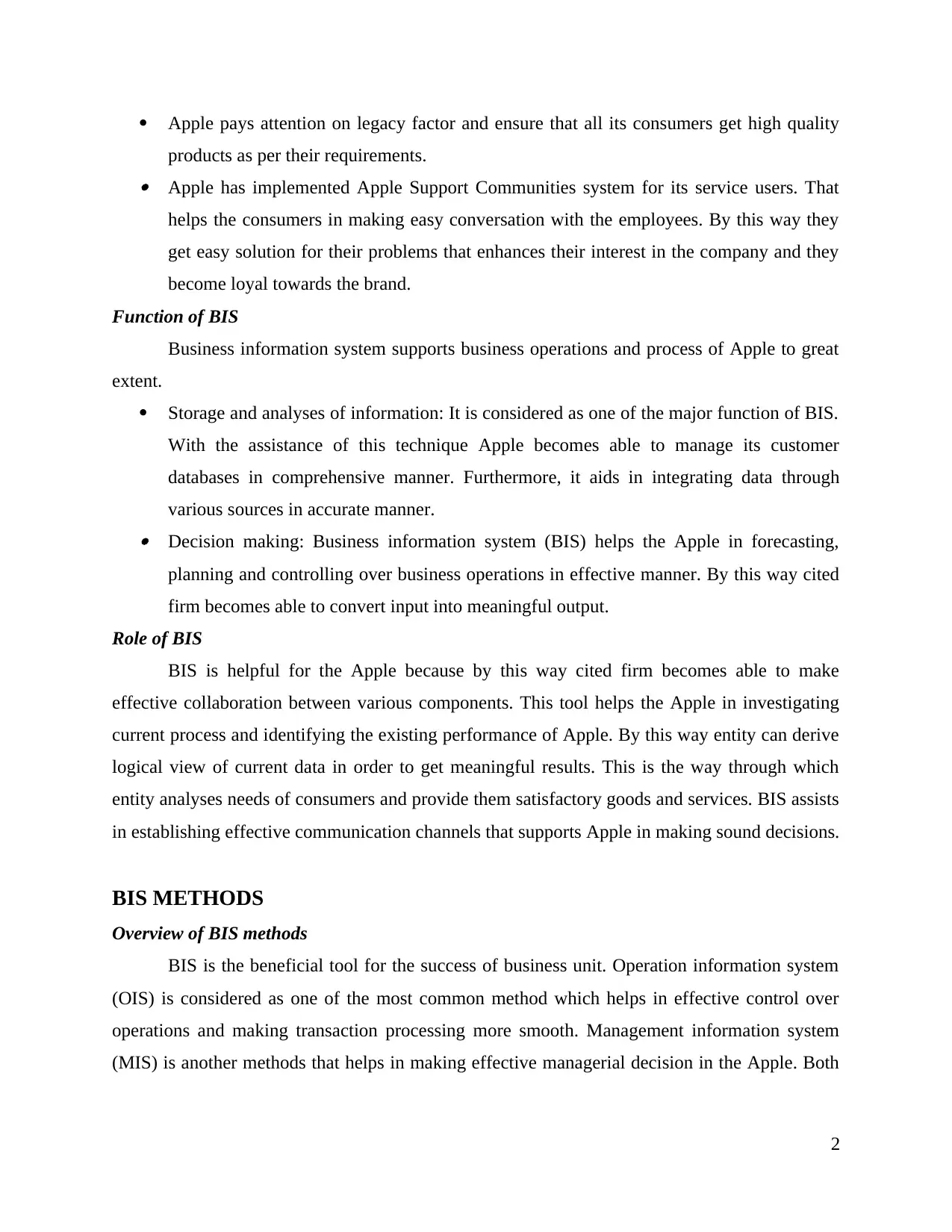
Apple pays attention on legacy factor and ensure that all its consumers get high quality
products as per their requirements. Apple has implemented Apple Support Communities system for its service users. That
helps the consumers in making easy conversation with the employees. By this way they
get easy solution for their problems that enhances their interest in the company and they
become loyal towards the brand.
Function of BIS
Business information system supports business operations and process of Apple to great
extent.
Storage and analyses of information: It is considered as one of the major function of BIS.
With the assistance of this technique Apple becomes able to manage its customer
databases in comprehensive manner. Furthermore, it aids in integrating data through
various sources in accurate manner. Decision making: Business information system (BIS) helps the Apple in forecasting,
planning and controlling over business operations in effective manner. By this way cited
firm becomes able to convert input into meaningful output.
Role of BIS
BIS is helpful for the Apple because by this way cited firm becomes able to make
effective collaboration between various components. This tool helps the Apple in investigating
current process and identifying the existing performance of Apple. By this way entity can derive
logical view of current data in order to get meaningful results. This is the way through which
entity analyses needs of consumers and provide them satisfactory goods and services. BIS assists
in establishing effective communication channels that supports Apple in making sound decisions.
BIS METHODS
Overview of BIS methods
BIS is the beneficial tool for the success of business unit. Operation information system
(OIS) is considered as one of the most common method which helps in effective control over
operations and making transaction processing more smooth. Management information system
(MIS) is another methods that helps in making effective managerial decision in the Apple. Both
2
products as per their requirements. Apple has implemented Apple Support Communities system for its service users. That
helps the consumers in making easy conversation with the employees. By this way they
get easy solution for their problems that enhances their interest in the company and they
become loyal towards the brand.
Function of BIS
Business information system supports business operations and process of Apple to great
extent.
Storage and analyses of information: It is considered as one of the major function of BIS.
With the assistance of this technique Apple becomes able to manage its customer
databases in comprehensive manner. Furthermore, it aids in integrating data through
various sources in accurate manner. Decision making: Business information system (BIS) helps the Apple in forecasting,
planning and controlling over business operations in effective manner. By this way cited
firm becomes able to convert input into meaningful output.
Role of BIS
BIS is helpful for the Apple because by this way cited firm becomes able to make
effective collaboration between various components. This tool helps the Apple in investigating
current process and identifying the existing performance of Apple. By this way entity can derive
logical view of current data in order to get meaningful results. This is the way through which
entity analyses needs of consumers and provide them satisfactory goods and services. BIS assists
in establishing effective communication channels that supports Apple in making sound decisions.
BIS METHODS
Overview of BIS methods
BIS is the beneficial tool for the success of business unit. Operation information system
(OIS) is considered as one of the most common method which helps in effective control over
operations and making transaction processing more smooth. Management information system
(MIS) is another methods that helps in making effective managerial decision in the Apple. Both
2
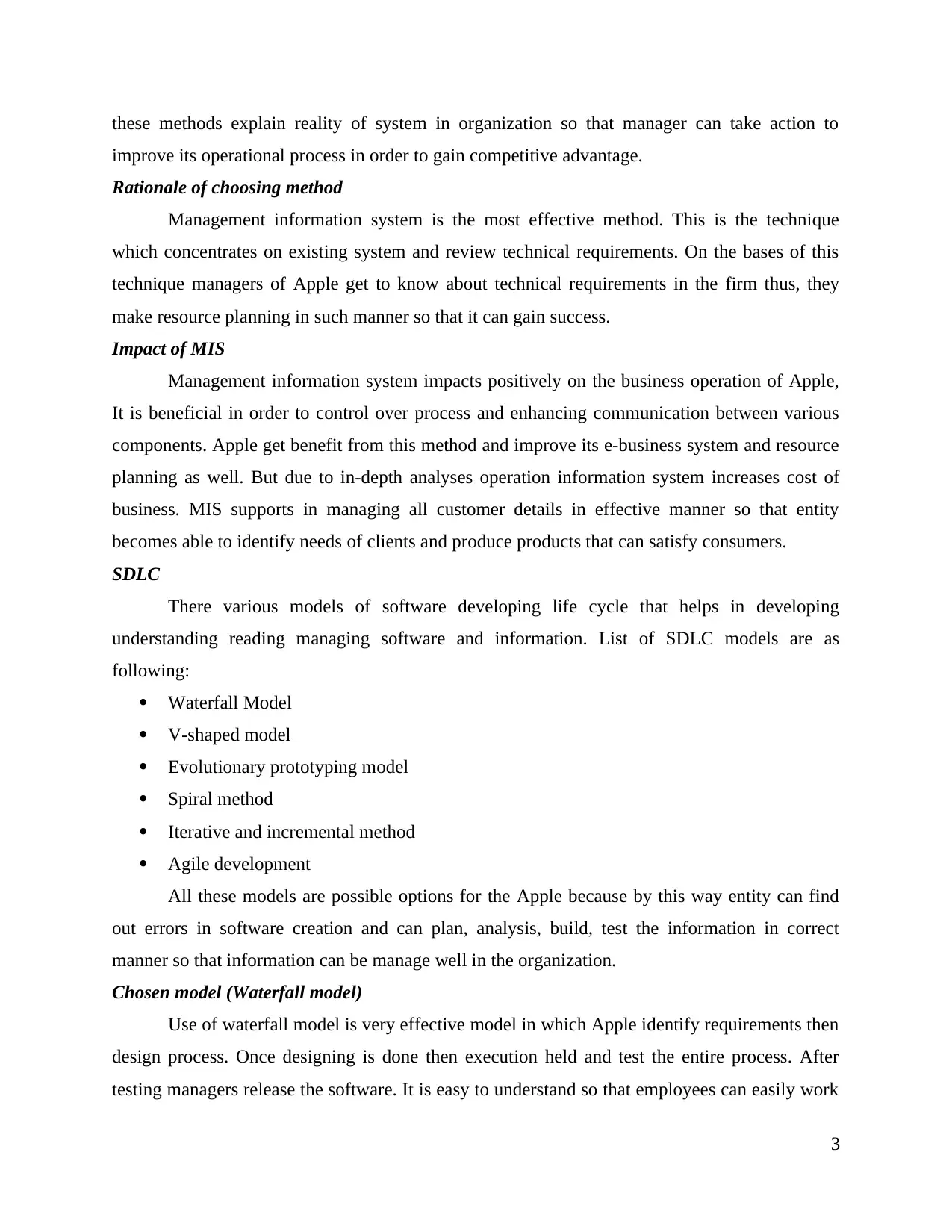
these methods explain reality of system in organization so that manager can take action to
improve its operational process in order to gain competitive advantage.
Rationale of choosing method
Management information system is the most effective method. This is the technique
which concentrates on existing system and review technical requirements. On the bases of this
technique managers of Apple get to know about technical requirements in the firm thus, they
make resource planning in such manner so that it can gain success.
Impact of MIS
Management information system impacts positively on the business operation of Apple,
It is beneficial in order to control over process and enhancing communication between various
components. Apple get benefit from this method and improve its e-business system and resource
planning as well. But due to in-depth analyses operation information system increases cost of
business. MIS supports in managing all customer details in effective manner so that entity
becomes able to identify needs of clients and produce products that can satisfy consumers.
SDLC
There various models of software developing life cycle that helps in developing
understanding reading managing software and information. List of SDLC models are as
following:
Waterfall Model
V-shaped model
Evolutionary prototyping model
Spiral method
Iterative and incremental method
Agile development
All these models are possible options for the Apple because by this way entity can find
out errors in software creation and can plan, analysis, build, test the information in correct
manner so that information can be manage well in the organization.
Chosen model (Waterfall model)
Use of waterfall model is very effective model in which Apple identify requirements then
design process. Once designing is done then execution held and test the entire process. After
testing managers release the software. It is easy to understand so that employees can easily work
3
improve its operational process in order to gain competitive advantage.
Rationale of choosing method
Management information system is the most effective method. This is the technique
which concentrates on existing system and review technical requirements. On the bases of this
technique managers of Apple get to know about technical requirements in the firm thus, they
make resource planning in such manner so that it can gain success.
Impact of MIS
Management information system impacts positively on the business operation of Apple,
It is beneficial in order to control over process and enhancing communication between various
components. Apple get benefit from this method and improve its e-business system and resource
planning as well. But due to in-depth analyses operation information system increases cost of
business. MIS supports in managing all customer details in effective manner so that entity
becomes able to identify needs of clients and produce products that can satisfy consumers.
SDLC
There various models of software developing life cycle that helps in developing
understanding reading managing software and information. List of SDLC models are as
following:
Waterfall Model
V-shaped model
Evolutionary prototyping model
Spiral method
Iterative and incremental method
Agile development
All these models are possible options for the Apple because by this way entity can find
out errors in software creation and can plan, analysis, build, test the information in correct
manner so that information can be manage well in the organization.
Chosen model (Waterfall model)
Use of waterfall model is very effective model in which Apple identify requirements then
design process. Once designing is done then execution held and test the entire process. After
testing managers release the software. It is easy to understand so that employees can easily work
3
You're viewing a preview
Unlock full access by subscribing today!
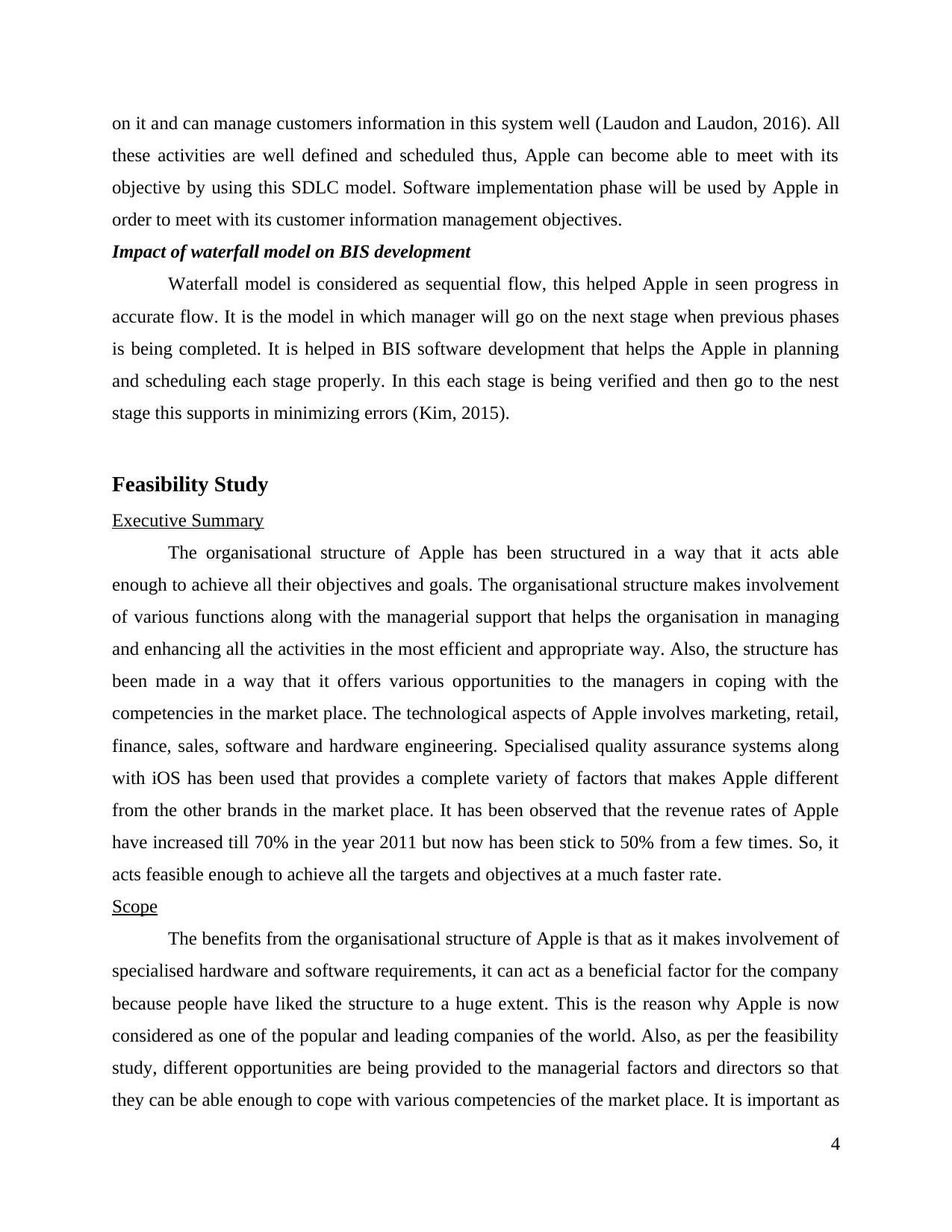
on it and can manage customers information in this system well (Laudon and Laudon, 2016). All
these activities are well defined and scheduled thus, Apple can become able to meet with its
objective by using this SDLC model. Software implementation phase will be used by Apple in
order to meet with its customer information management objectives.
Impact of waterfall model on BIS development
Waterfall model is considered as sequential flow, this helped Apple in seen progress in
accurate flow. It is the model in which manager will go on the next stage when previous phases
is being completed. It is helped in BIS software development that helps the Apple in planning
and scheduling each stage properly. In this each stage is being verified and then go to the nest
stage this supports in minimizing errors (Kim, 2015).
Feasibility Study
Executive Summary
The organisational structure of Apple has been structured in a way that it acts able
enough to achieve all their objectives and goals. The organisational structure makes involvement
of various functions along with the managerial support that helps the organisation in managing
and enhancing all the activities in the most efficient and appropriate way. Also, the structure has
been made in a way that it offers various opportunities to the managers in coping with the
competencies in the market place. The technological aspects of Apple involves marketing, retail,
finance, sales, software and hardware engineering. Specialised quality assurance systems along
with iOS has been used that provides a complete variety of factors that makes Apple different
from the other brands in the market place. It has been observed that the revenue rates of Apple
have increased till 70% in the year 2011 but now has been stick to 50% from a few times. So, it
acts feasible enough to achieve all the targets and objectives at a much faster rate.
Scope
The benefits from the organisational structure of Apple is that as it makes involvement of
specialised hardware and software requirements, it can act as a beneficial factor for the company
because people have liked the structure to a huge extent. This is the reason why Apple is now
considered as one of the popular and leading companies of the world. Also, as per the feasibility
study, different opportunities are being provided to the managerial factors and directors so that
they can be able enough to cope with various competencies of the market place. It is important as
4
these activities are well defined and scheduled thus, Apple can become able to meet with its
objective by using this SDLC model. Software implementation phase will be used by Apple in
order to meet with its customer information management objectives.
Impact of waterfall model on BIS development
Waterfall model is considered as sequential flow, this helped Apple in seen progress in
accurate flow. It is the model in which manager will go on the next stage when previous phases
is being completed. It is helped in BIS software development that helps the Apple in planning
and scheduling each stage properly. In this each stage is being verified and then go to the nest
stage this supports in minimizing errors (Kim, 2015).
Feasibility Study
Executive Summary
The organisational structure of Apple has been structured in a way that it acts able
enough to achieve all their objectives and goals. The organisational structure makes involvement
of various functions along with the managerial support that helps the organisation in managing
and enhancing all the activities in the most efficient and appropriate way. Also, the structure has
been made in a way that it offers various opportunities to the managers in coping with the
competencies in the market place. The technological aspects of Apple involves marketing, retail,
finance, sales, software and hardware engineering. Specialised quality assurance systems along
with iOS has been used that provides a complete variety of factors that makes Apple different
from the other brands in the market place. It has been observed that the revenue rates of Apple
have increased till 70% in the year 2011 but now has been stick to 50% from a few times. So, it
acts feasible enough to achieve all the targets and objectives at a much faster rate.
Scope
The benefits from the organisational structure of Apple is that as it makes involvement of
specialised hardware and software requirements, it can act as a beneficial factor for the company
because people have liked the structure to a huge extent. This is the reason why Apple is now
considered as one of the popular and leading companies of the world. Also, as per the feasibility
study, different opportunities are being provided to the managerial factors and directors so that
they can be able enough to cope with various competencies of the market place. It is important as
4
Paraphrase This Document
Need a fresh take? Get an instant paraphrase of this document with our AI Paraphraser
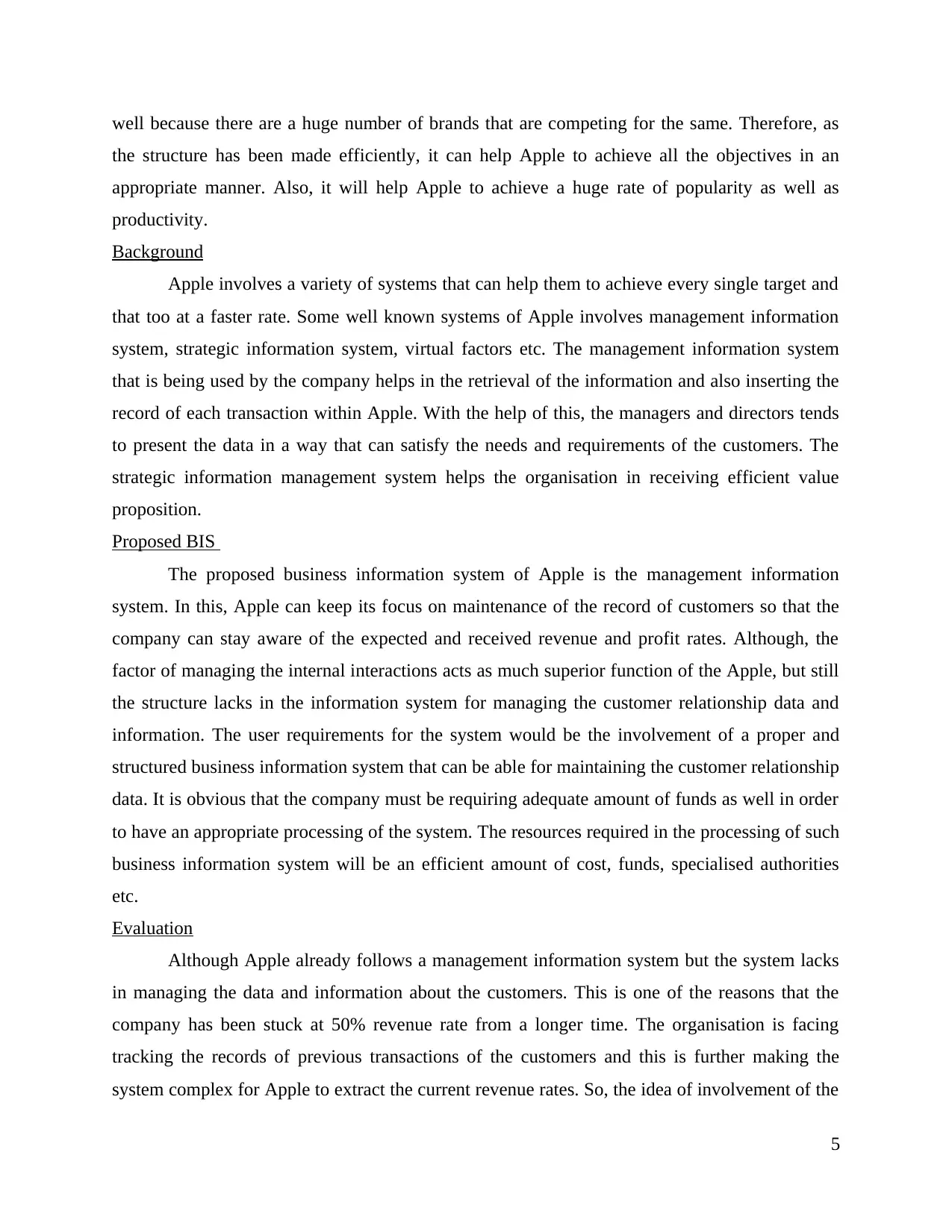
well because there are a huge number of brands that are competing for the same. Therefore, as
the structure has been made efficiently, it can help Apple to achieve all the objectives in an
appropriate manner. Also, it will help Apple to achieve a huge rate of popularity as well as
productivity.
Background
Apple involves a variety of systems that can help them to achieve every single target and
that too at a faster rate. Some well known systems of Apple involves management information
system, strategic information system, virtual factors etc. The management information system
that is being used by the company helps in the retrieval of the information and also inserting the
record of each transaction within Apple. With the help of this, the managers and directors tends
to present the data in a way that can satisfy the needs and requirements of the customers. The
strategic information management system helps the organisation in receiving efficient value
proposition.
Proposed BIS
The proposed business information system of Apple is the management information
system. In this, Apple can keep its focus on maintenance of the record of customers so that the
company can stay aware of the expected and received revenue and profit rates. Although, the
factor of managing the internal interactions acts as much superior function of the Apple, but still
the structure lacks in the information system for managing the customer relationship data and
information. The user requirements for the system would be the involvement of a proper and
structured business information system that can be able for maintaining the customer relationship
data. It is obvious that the company must be requiring adequate amount of funds as well in order
to have an appropriate processing of the system. The resources required in the processing of such
business information system will be an efficient amount of cost, funds, specialised authorities
etc.
Evaluation
Although Apple already follows a management information system but the system lacks
in managing the data and information about the customers. This is one of the reasons that the
company has been stuck at 50% revenue rate from a longer time. The organisation is facing
tracking the records of previous transactions of the customers and this is further making the
system complex for Apple to extract the current revenue rates. So, the idea of involvement of the
5
the structure has been made efficiently, it can help Apple to achieve all the objectives in an
appropriate manner. Also, it will help Apple to achieve a huge rate of popularity as well as
productivity.
Background
Apple involves a variety of systems that can help them to achieve every single target and
that too at a faster rate. Some well known systems of Apple involves management information
system, strategic information system, virtual factors etc. The management information system
that is being used by the company helps in the retrieval of the information and also inserting the
record of each transaction within Apple. With the help of this, the managers and directors tends
to present the data in a way that can satisfy the needs and requirements of the customers. The
strategic information management system helps the organisation in receiving efficient value
proposition.
Proposed BIS
The proposed business information system of Apple is the management information
system. In this, Apple can keep its focus on maintenance of the record of customers so that the
company can stay aware of the expected and received revenue and profit rates. Although, the
factor of managing the internal interactions acts as much superior function of the Apple, but still
the structure lacks in the information system for managing the customer relationship data and
information. The user requirements for the system would be the involvement of a proper and
structured business information system that can be able for maintaining the customer relationship
data. It is obvious that the company must be requiring adequate amount of funds as well in order
to have an appropriate processing of the system. The resources required in the processing of such
business information system will be an efficient amount of cost, funds, specialised authorities
etc.
Evaluation
Although Apple already follows a management information system but the system lacks
in managing the data and information about the customers. This is one of the reasons that the
company has been stuck at 50% revenue rate from a longer time. The organisation is facing
tracking the records of previous transactions of the customers and this is further making the
system complex for Apple to extract the current revenue rates. So, the idea of involvement of the
5
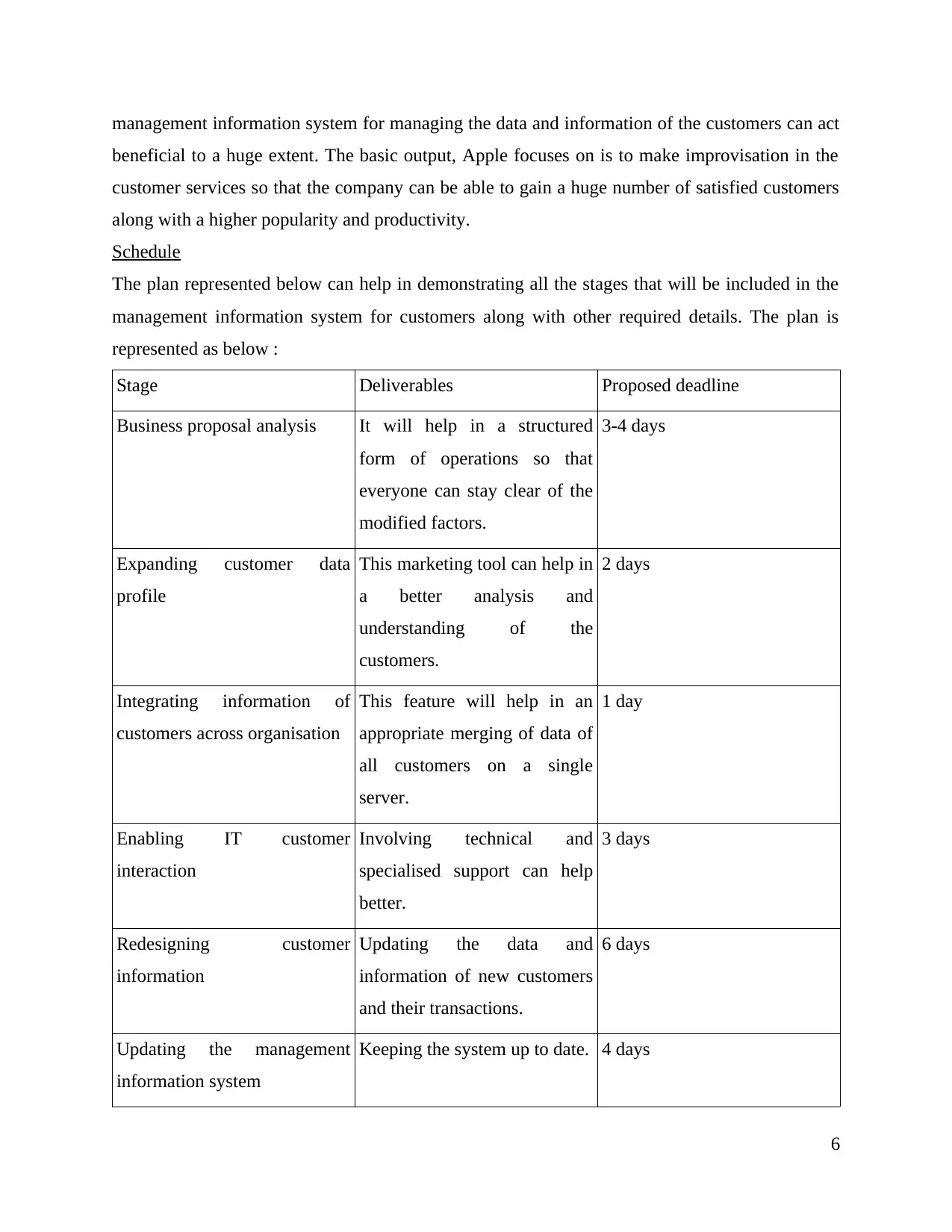
management information system for managing the data and information of the customers can act
beneficial to a huge extent. The basic output, Apple focuses on is to make improvisation in the
customer services so that the company can be able to gain a huge number of satisfied customers
along with a higher popularity and productivity.
Schedule
The plan represented below can help in demonstrating all the stages that will be included in the
management information system for customers along with other required details. The plan is
represented as below :
Stage Deliverables Proposed deadline
Business proposal analysis It will help in a structured
form of operations so that
everyone can stay clear of the
modified factors.
3-4 days
Expanding customer data
profile
This marketing tool can help in
a better analysis and
understanding of the
customers.
2 days
Integrating information of
customers across organisation
This feature will help in an
appropriate merging of data of
all customers on a single
server.
1 day
Enabling IT customer
interaction
Involving technical and
specialised support can help
better.
3 days
Redesigning customer
information
Updating the data and
information of new customers
and their transactions.
6 days
Updating the management
information system
Keeping the system up to date. 4 days
6
beneficial to a huge extent. The basic output, Apple focuses on is to make improvisation in the
customer services so that the company can be able to gain a huge number of satisfied customers
along with a higher popularity and productivity.
Schedule
The plan represented below can help in demonstrating all the stages that will be included in the
management information system for customers along with other required details. The plan is
represented as below :
Stage Deliverables Proposed deadline
Business proposal analysis It will help in a structured
form of operations so that
everyone can stay clear of the
modified factors.
3-4 days
Expanding customer data
profile
This marketing tool can help in
a better analysis and
understanding of the
customers.
2 days
Integrating information of
customers across organisation
This feature will help in an
appropriate merging of data of
all customers on a single
server.
1 day
Enabling IT customer
interaction
Involving technical and
specialised support can help
better.
3 days
Redesigning customer
information
Updating the data and
information of new customers
and their transactions.
6 days
Updating the management
information system
Keeping the system up to date. 4 days
6
You're viewing a preview
Unlock full access by subscribing today!
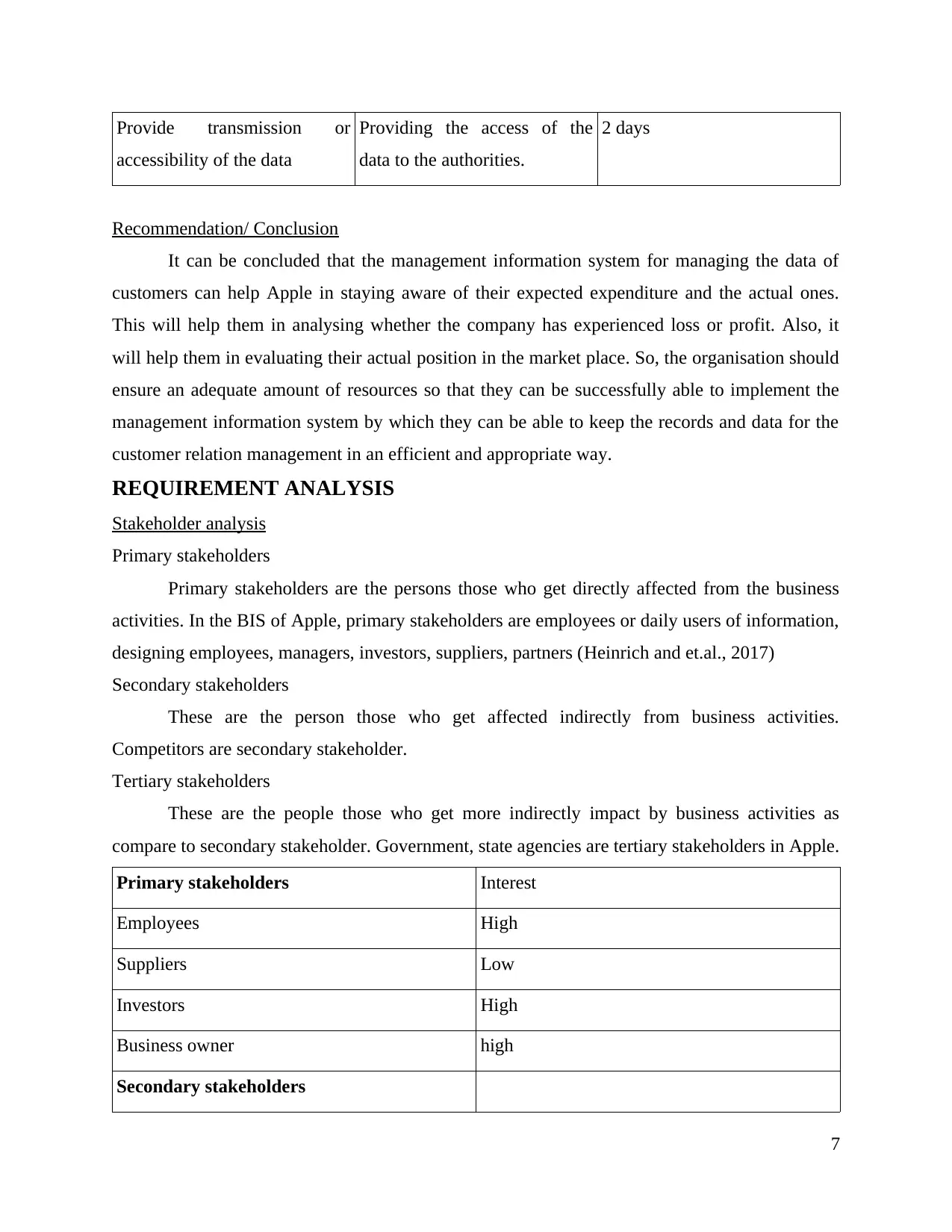
Provide transmission or
accessibility of the data
Providing the access of the
data to the authorities.
2 days
Recommendation/ Conclusion
It can be concluded that the management information system for managing the data of
customers can help Apple in staying aware of their expected expenditure and the actual ones.
This will help them in analysing whether the company has experienced loss or profit. Also, it
will help them in evaluating their actual position in the market place. So, the organisation should
ensure an adequate amount of resources so that they can be successfully able to implement the
management information system by which they can be able to keep the records and data for the
customer relation management in an efficient and appropriate way.
REQUIREMENT ANALYSIS
Stakeholder analysis
Primary stakeholders
Primary stakeholders are the persons those who get directly affected from the business
activities. In the BIS of Apple, primary stakeholders are employees or daily users of information,
designing employees, managers, investors, suppliers, partners (Heinrich and et.al., 2017)
Secondary stakeholders
These are the person those who get affected indirectly from business activities.
Competitors are secondary stakeholder.
Tertiary stakeholders
These are the people those who get more indirectly impact by business activities as
compare to secondary stakeholder. Government, state agencies are tertiary stakeholders in Apple.
Primary stakeholders Interest
Employees High
Suppliers Low
Investors High
Business owner high
Secondary stakeholders
7
accessibility of the data
Providing the access of the
data to the authorities.
2 days
Recommendation/ Conclusion
It can be concluded that the management information system for managing the data of
customers can help Apple in staying aware of their expected expenditure and the actual ones.
This will help them in analysing whether the company has experienced loss or profit. Also, it
will help them in evaluating their actual position in the market place. So, the organisation should
ensure an adequate amount of resources so that they can be successfully able to implement the
management information system by which they can be able to keep the records and data for the
customer relation management in an efficient and appropriate way.
REQUIREMENT ANALYSIS
Stakeholder analysis
Primary stakeholders
Primary stakeholders are the persons those who get directly affected from the business
activities. In the BIS of Apple, primary stakeholders are employees or daily users of information,
designing employees, managers, investors, suppliers, partners (Heinrich and et.al., 2017)
Secondary stakeholders
These are the person those who get affected indirectly from business activities.
Competitors are secondary stakeholder.
Tertiary stakeholders
These are the people those who get more indirectly impact by business activities as
compare to secondary stakeholder. Government, state agencies are tertiary stakeholders in Apple.
Primary stakeholders Interest
Employees High
Suppliers Low
Investors High
Business owner high
Secondary stakeholders
7
Paraphrase This Document
Need a fresh take? Get an instant paraphrase of this document with our AI Paraphraser
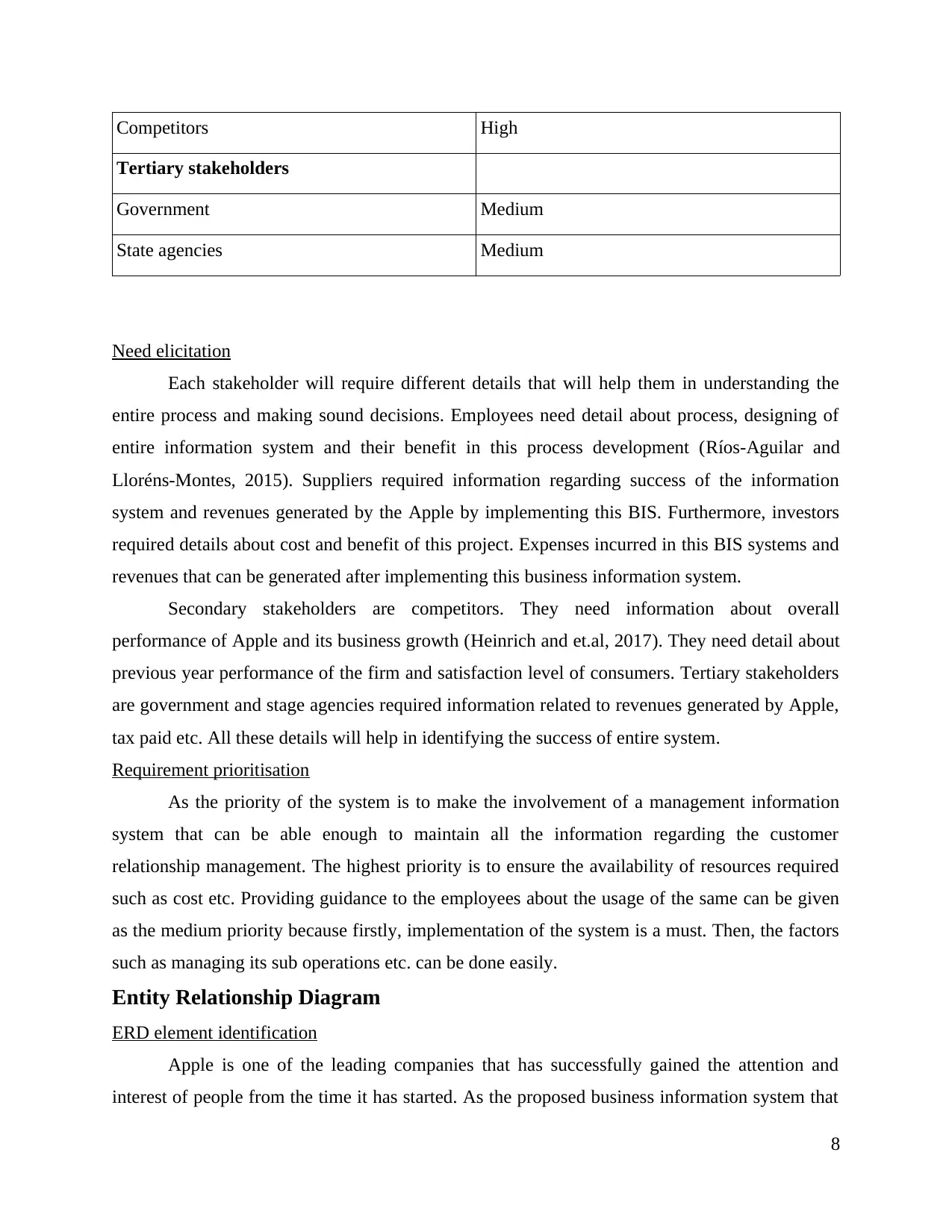
Competitors High
Tertiary stakeholders
Government Medium
State agencies Medium
Need elicitation
Each stakeholder will require different details that will help them in understanding the
entire process and making sound decisions. Employees need detail about process, designing of
entire information system and their benefit in this process development (Ríos-Aguilar and
Lloréns-Montes, 2015). Suppliers required information regarding success of the information
system and revenues generated by the Apple by implementing this BIS. Furthermore, investors
required details about cost and benefit of this project. Expenses incurred in this BIS systems and
revenues that can be generated after implementing this business information system.
Secondary stakeholders are competitors. They need information about overall
performance of Apple and its business growth (Heinrich and et.al, 2017). They need detail about
previous year performance of the firm and satisfaction level of consumers. Tertiary stakeholders
are government and stage agencies required information related to revenues generated by Apple,
tax paid etc. All these details will help in identifying the success of entire system.
Requirement prioritisation
As the priority of the system is to make the involvement of a management information
system that can be able enough to maintain all the information regarding the customer
relationship management. The highest priority is to ensure the availability of resources required
such as cost etc. Providing guidance to the employees about the usage of the same can be given
as the medium priority because firstly, implementation of the system is a must. Then, the factors
such as managing its sub operations etc. can be done easily.
Entity Relationship Diagram
ERD element identification
Apple is one of the leading companies that has successfully gained the attention and
interest of people from the time it has started. As the proposed business information system that
8
Tertiary stakeholders
Government Medium
State agencies Medium
Need elicitation
Each stakeholder will require different details that will help them in understanding the
entire process and making sound decisions. Employees need detail about process, designing of
entire information system and their benefit in this process development (Ríos-Aguilar and
Lloréns-Montes, 2015). Suppliers required information regarding success of the information
system and revenues generated by the Apple by implementing this BIS. Furthermore, investors
required details about cost and benefit of this project. Expenses incurred in this BIS systems and
revenues that can be generated after implementing this business information system.
Secondary stakeholders are competitors. They need information about overall
performance of Apple and its business growth (Heinrich and et.al, 2017). They need detail about
previous year performance of the firm and satisfaction level of consumers. Tertiary stakeholders
are government and stage agencies required information related to revenues generated by Apple,
tax paid etc. All these details will help in identifying the success of entire system.
Requirement prioritisation
As the priority of the system is to make the involvement of a management information
system that can be able enough to maintain all the information regarding the customer
relationship management. The highest priority is to ensure the availability of resources required
such as cost etc. Providing guidance to the employees about the usage of the same can be given
as the medium priority because firstly, implementation of the system is a must. Then, the factors
such as managing its sub operations etc. can be done easily.
Entity Relationship Diagram
ERD element identification
Apple is one of the leading companies that has successfully gained the attention and
interest of people from the time it has started. As the proposed business information system that
8
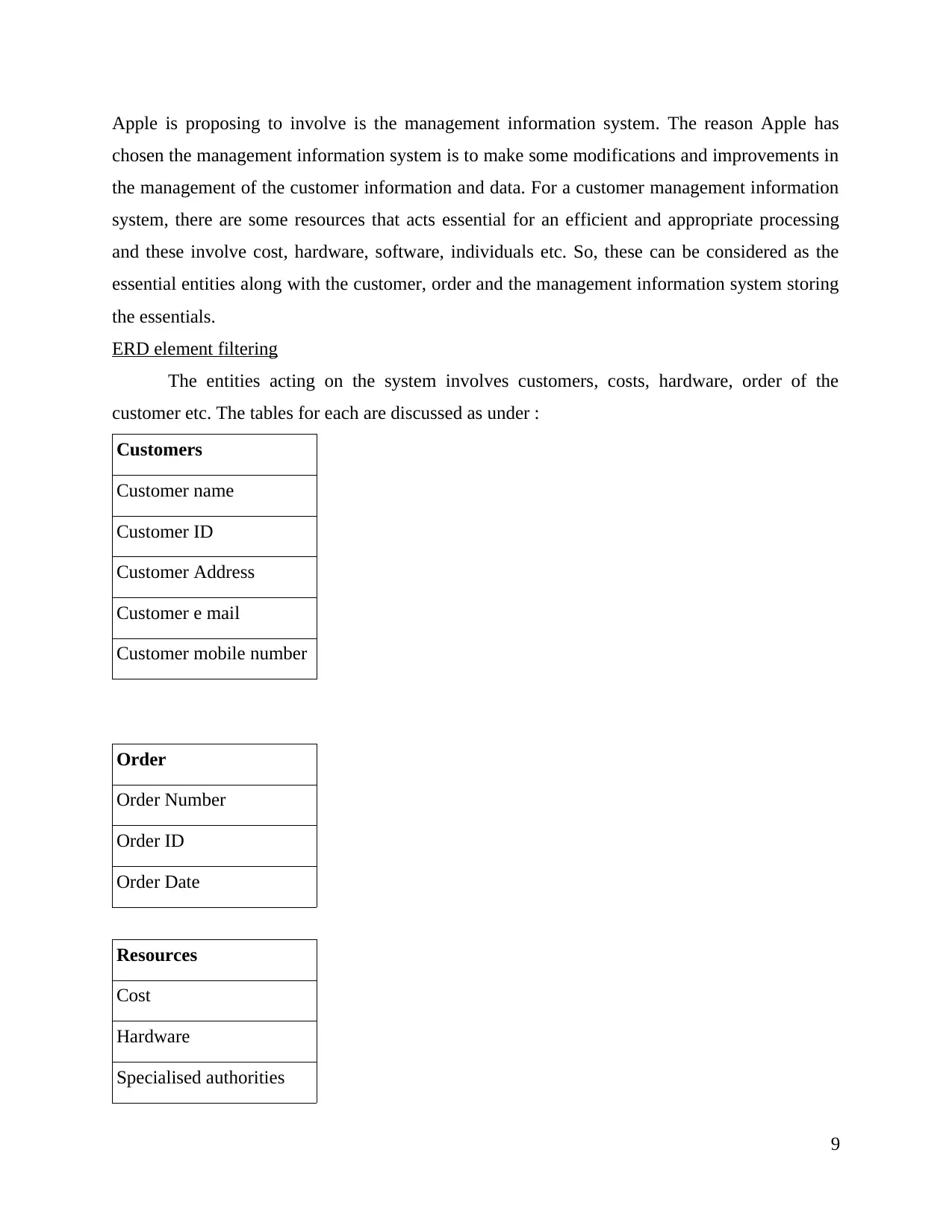
Apple is proposing to involve is the management information system. The reason Apple has
chosen the management information system is to make some modifications and improvements in
the management of the customer information and data. For a customer management information
system, there are some resources that acts essential for an efficient and appropriate processing
and these involve cost, hardware, software, individuals etc. So, these can be considered as the
essential entities along with the customer, order and the management information system storing
the essentials.
ERD element filtering
The entities acting on the system involves customers, costs, hardware, order of the
customer etc. The tables for each are discussed as under :
Customers
Customer name
Customer ID
Customer Address
Customer e mail
Customer mobile number
Order
Order Number
Order ID
Order Date
Resources
Cost
Hardware
Specialised authorities
9
chosen the management information system is to make some modifications and improvements in
the management of the customer information and data. For a customer management information
system, there are some resources that acts essential for an efficient and appropriate processing
and these involve cost, hardware, software, individuals etc. So, these can be considered as the
essential entities along with the customer, order and the management information system storing
the essentials.
ERD element filtering
The entities acting on the system involves customers, costs, hardware, order of the
customer etc. The tables for each are discussed as under :
Customers
Customer name
Customer ID
Customer Address
Customer e mail
Customer mobile number
Order
Order Number
Order ID
Order Date
Resources
Cost
Hardware
Specialised authorities
9
You're viewing a preview
Unlock full access by subscribing today!
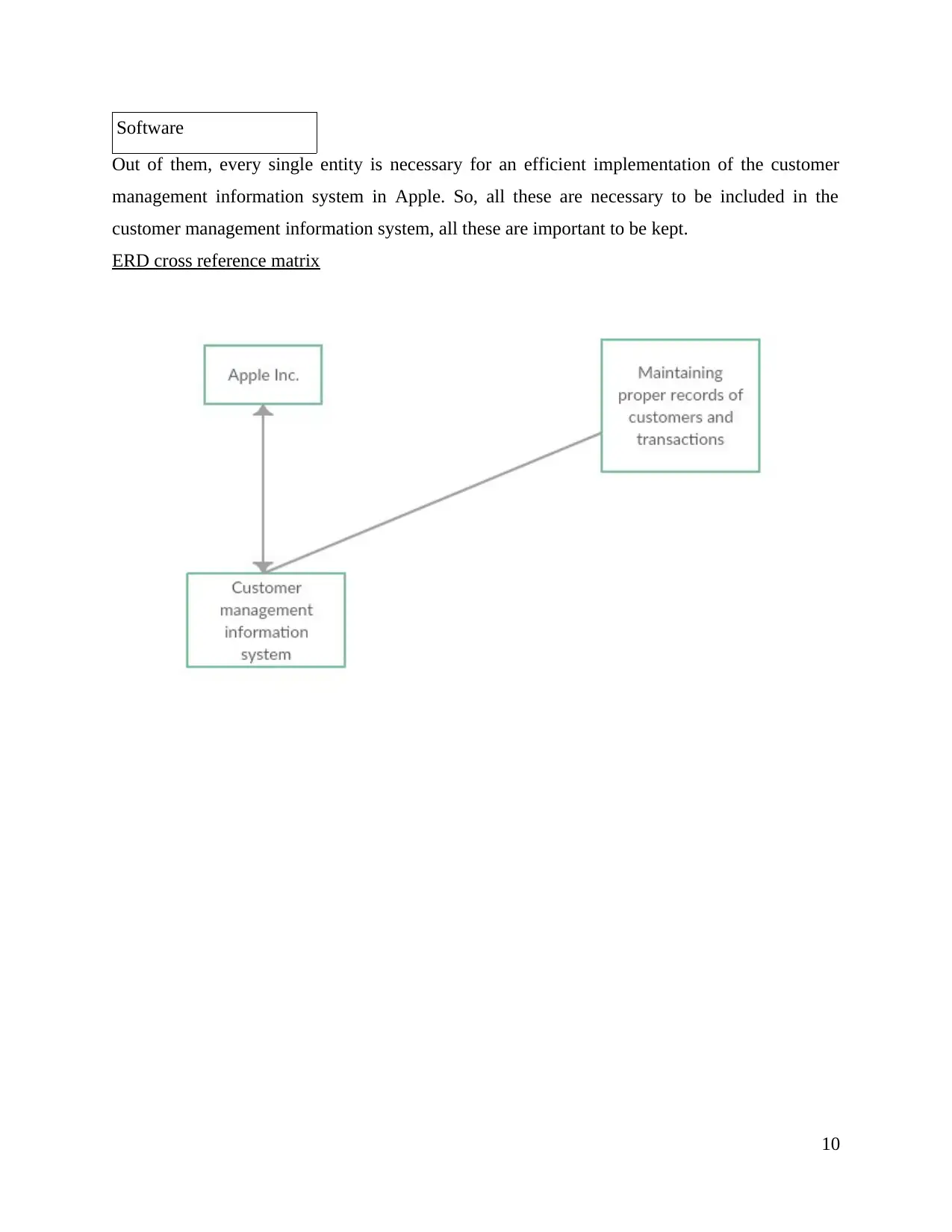
Software
Out of them, every single entity is necessary for an efficient implementation of the customer
management information system in Apple. So, all these are necessary to be included in the
customer management information system, all these are important to be kept.
ERD cross reference matrix
10
Out of them, every single entity is necessary for an efficient implementation of the customer
management information system in Apple. So, all these are necessary to be included in the
customer management information system, all these are important to be kept.
ERD cross reference matrix
10
Paraphrase This Document
Need a fresh take? Get an instant paraphrase of this document with our AI Paraphraser
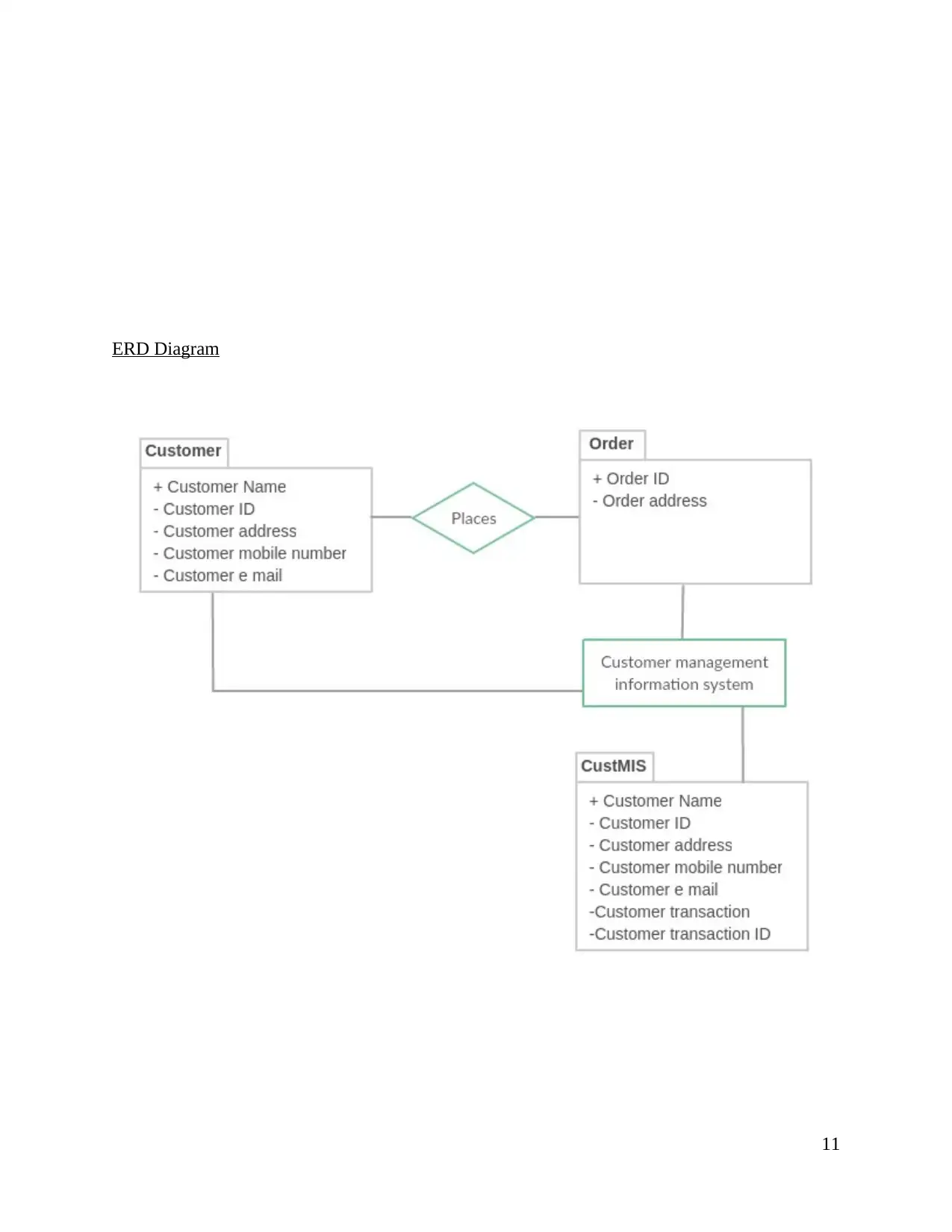
ERD Diagram
11
11
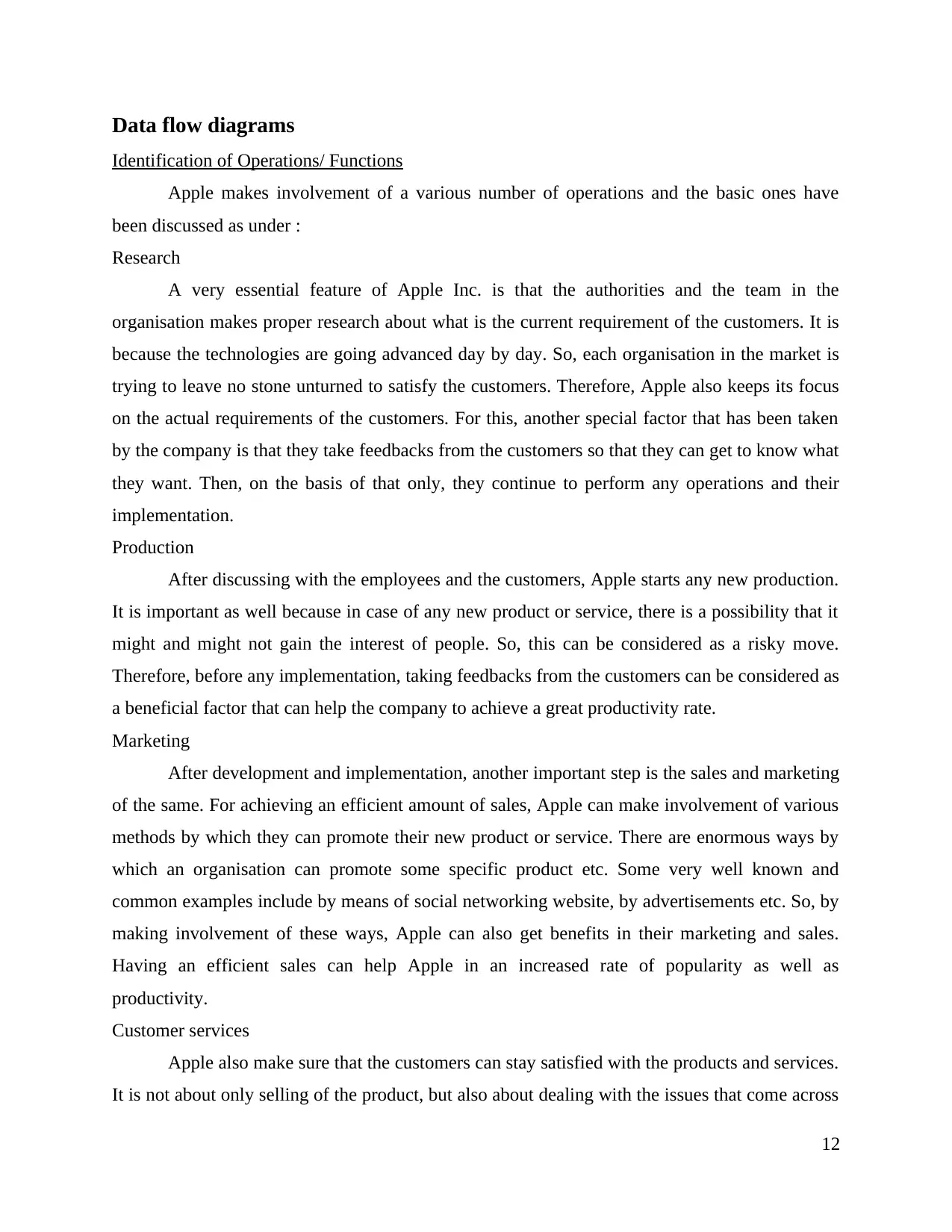
Data flow diagrams
Identification of Operations/ Functions
Apple makes involvement of a various number of operations and the basic ones have
been discussed as under :
Research
A very essential feature of Apple Inc. is that the authorities and the team in the
organisation makes proper research about what is the current requirement of the customers. It is
because the technologies are going advanced day by day. So, each organisation in the market is
trying to leave no stone unturned to satisfy the customers. Therefore, Apple also keeps its focus
on the actual requirements of the customers. For this, another special factor that has been taken
by the company is that they take feedbacks from the customers so that they can get to know what
they want. Then, on the basis of that only, they continue to perform any operations and their
implementation.
Production
After discussing with the employees and the customers, Apple starts any new production.
It is important as well because in case of any new product or service, there is a possibility that it
might and might not gain the interest of people. So, this can be considered as a risky move.
Therefore, before any implementation, taking feedbacks from the customers can be considered as
a beneficial factor that can help the company to achieve a great productivity rate.
Marketing
After development and implementation, another important step is the sales and marketing
of the same. For achieving an efficient amount of sales, Apple can make involvement of various
methods by which they can promote their new product or service. There are enormous ways by
which an organisation can promote some specific product etc. Some very well known and
common examples include by means of social networking website, by advertisements etc. So, by
making involvement of these ways, Apple can also get benefits in their marketing and sales.
Having an efficient sales can help Apple in an increased rate of popularity as well as
productivity.
Customer services
Apple also make sure that the customers can stay satisfied with the products and services.
It is not about only selling of the product, but also about dealing with the issues that come across
12
Identification of Operations/ Functions
Apple makes involvement of a various number of operations and the basic ones have
been discussed as under :
Research
A very essential feature of Apple Inc. is that the authorities and the team in the
organisation makes proper research about what is the current requirement of the customers. It is
because the technologies are going advanced day by day. So, each organisation in the market is
trying to leave no stone unturned to satisfy the customers. Therefore, Apple also keeps its focus
on the actual requirements of the customers. For this, another special factor that has been taken
by the company is that they take feedbacks from the customers so that they can get to know what
they want. Then, on the basis of that only, they continue to perform any operations and their
implementation.
Production
After discussing with the employees and the customers, Apple starts any new production.
It is important as well because in case of any new product or service, there is a possibility that it
might and might not gain the interest of people. So, this can be considered as a risky move.
Therefore, before any implementation, taking feedbacks from the customers can be considered as
a beneficial factor that can help the company to achieve a great productivity rate.
Marketing
After development and implementation, another important step is the sales and marketing
of the same. For achieving an efficient amount of sales, Apple can make involvement of various
methods by which they can promote their new product or service. There are enormous ways by
which an organisation can promote some specific product etc. Some very well known and
common examples include by means of social networking website, by advertisements etc. So, by
making involvement of these ways, Apple can also get benefits in their marketing and sales.
Having an efficient sales can help Apple in an increased rate of popularity as well as
productivity.
Customer services
Apple also make sure that the customers can stay satisfied with the products and services.
It is not about only selling of the product, but also about dealing with the issues that come across
12
You're viewing a preview
Unlock full access by subscribing today!
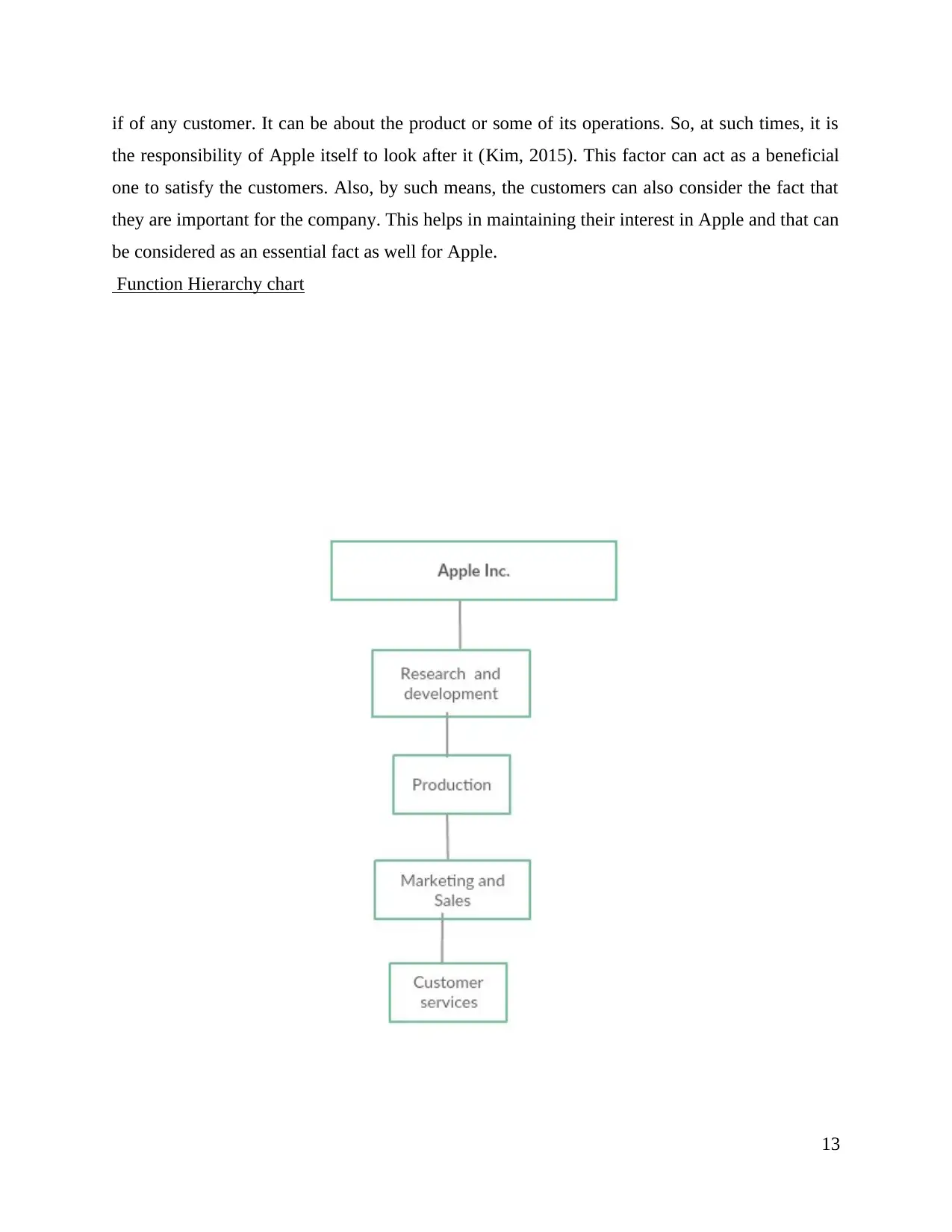
if of any customer. It can be about the product or some of its operations. So, at such times, it is
the responsibility of Apple itself to look after it (Kim, 2015). This factor can act as a beneficial
one to satisfy the customers. Also, by such means, the customers can also consider the fact that
they are important for the company. This helps in maintaining their interest in Apple and that can
be considered as an essential fact as well for Apple.
Function Hierarchy chart
13
the responsibility of Apple itself to look after it (Kim, 2015). This factor can act as a beneficial
one to satisfy the customers. Also, by such means, the customers can also consider the fact that
they are important for the company. This helps in maintaining their interest in Apple and that can
be considered as an essential fact as well for Apple.
Function Hierarchy chart
13
Paraphrase This Document
Need a fresh take? Get an instant paraphrase of this document with our AI Paraphraser
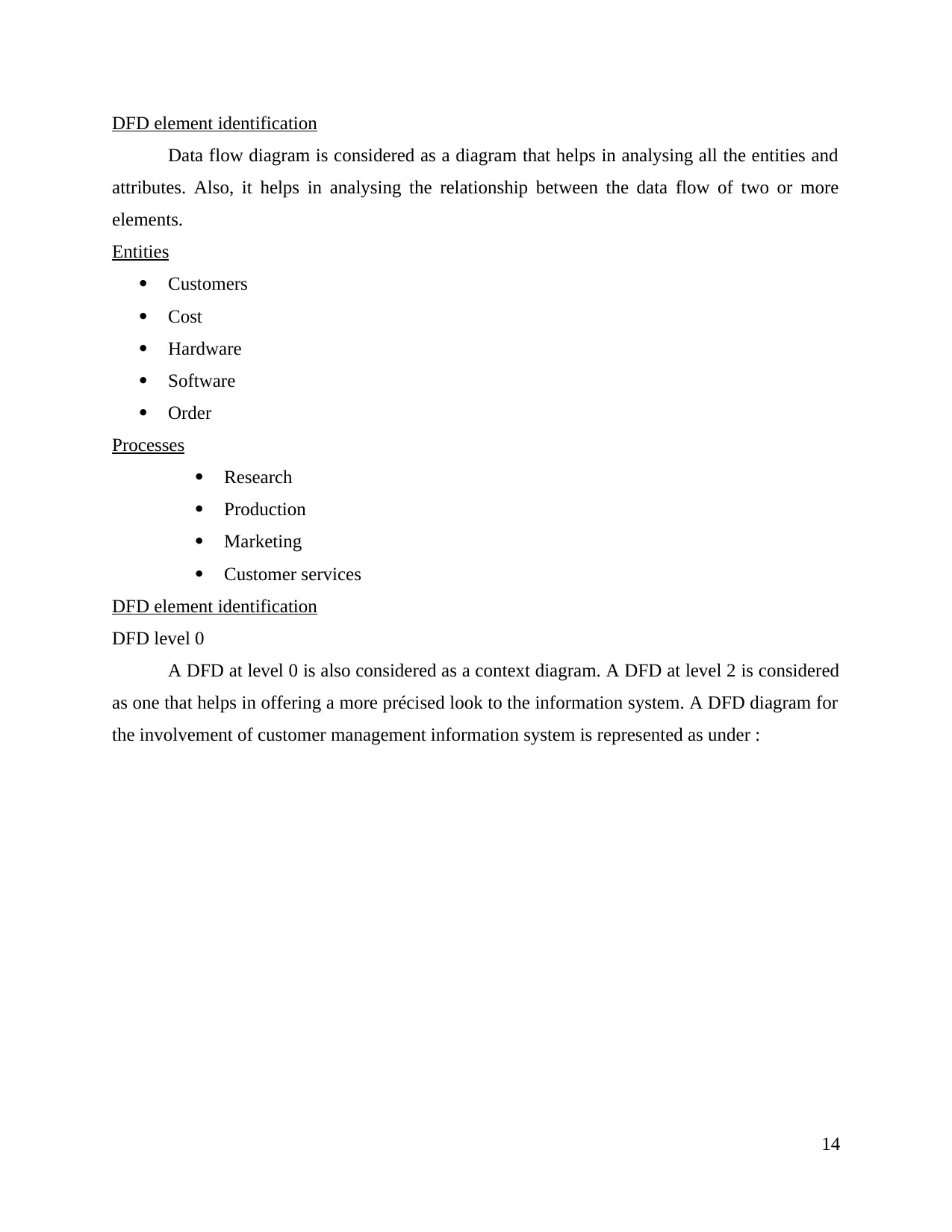
DFD element identification
Data flow diagram is considered as a diagram that helps in analysing all the entities and
attributes. Also, it helps in analysing the relationship between the data flow of two or more
elements.
Entities
Customers
Cost
Hardware
Software
Order
Processes
Research
Production
Marketing
Customer services
DFD element identification
DFD level 0
A DFD at level 0 is also considered as a context diagram. A DFD at level 2 is considered
as one that helps in offering a more précised look to the information system. A DFD diagram for
the involvement of customer management information system is represented as under :
14
Data flow diagram is considered as a diagram that helps in analysing all the entities and
attributes. Also, it helps in analysing the relationship between the data flow of two or more
elements.
Entities
Customers
Cost
Hardware
Software
Order
Processes
Research
Production
Marketing
Customer services
DFD element identification
DFD level 0
A DFD at level 0 is also considered as a context diagram. A DFD at level 2 is considered
as one that helps in offering a more précised look to the information system. A DFD diagram for
the involvement of customer management information system is represented as under :
14
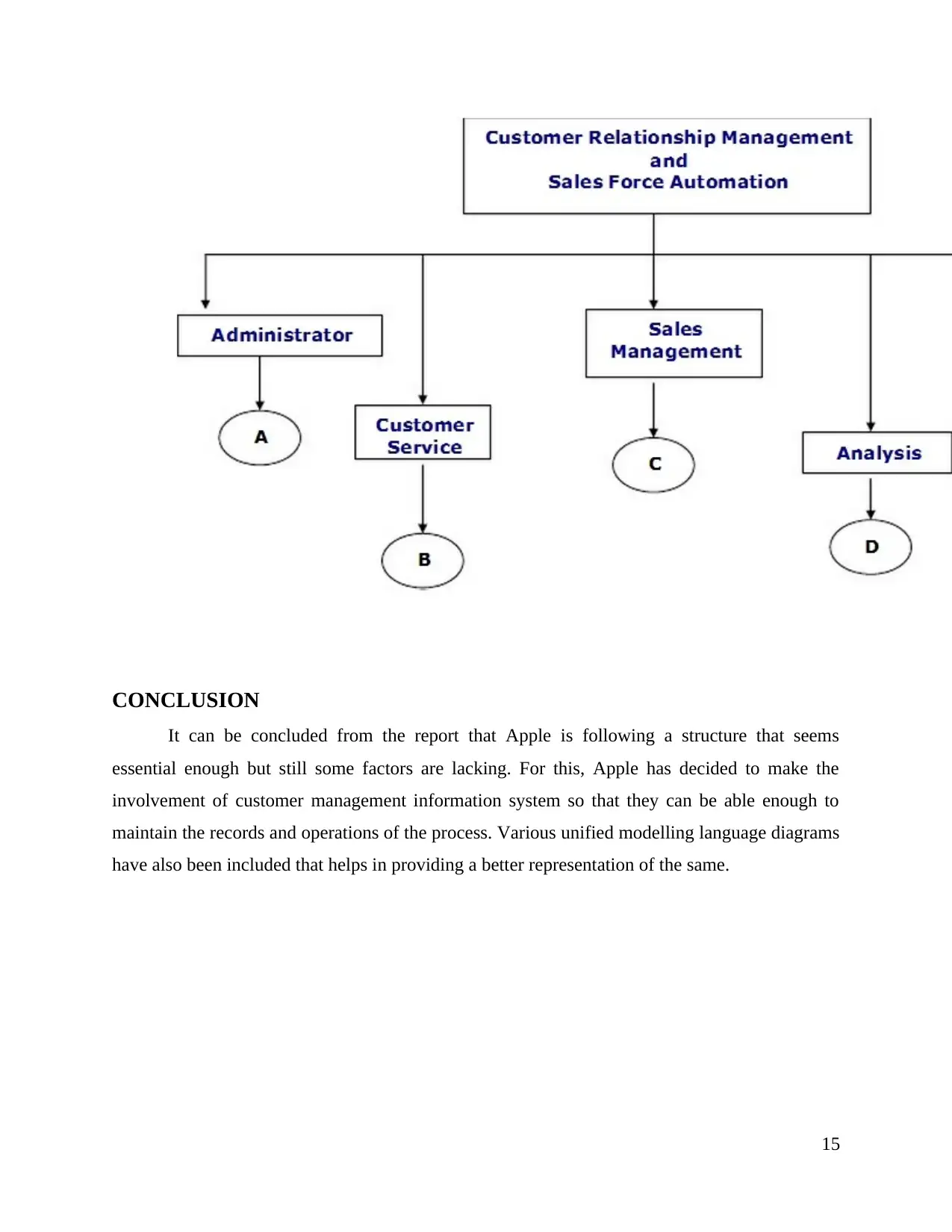
CONCLUSION
It can be concluded from the report that Apple is following a structure that seems
essential enough but still some factors are lacking. For this, Apple has decided to make the
involvement of customer management information system so that they can be able enough to
maintain the records and operations of the process. Various unified modelling language diagrams
have also been included that helps in providing a better representation of the same.
15
It can be concluded from the report that Apple is following a structure that seems
essential enough but still some factors are lacking. For this, Apple has decided to make the
involvement of customer management information system so that they can be able enough to
maintain the records and operations of the process. Various unified modelling language diagrams
have also been included that helps in providing a better representation of the same.
15
You're viewing a preview
Unlock full access by subscribing today!
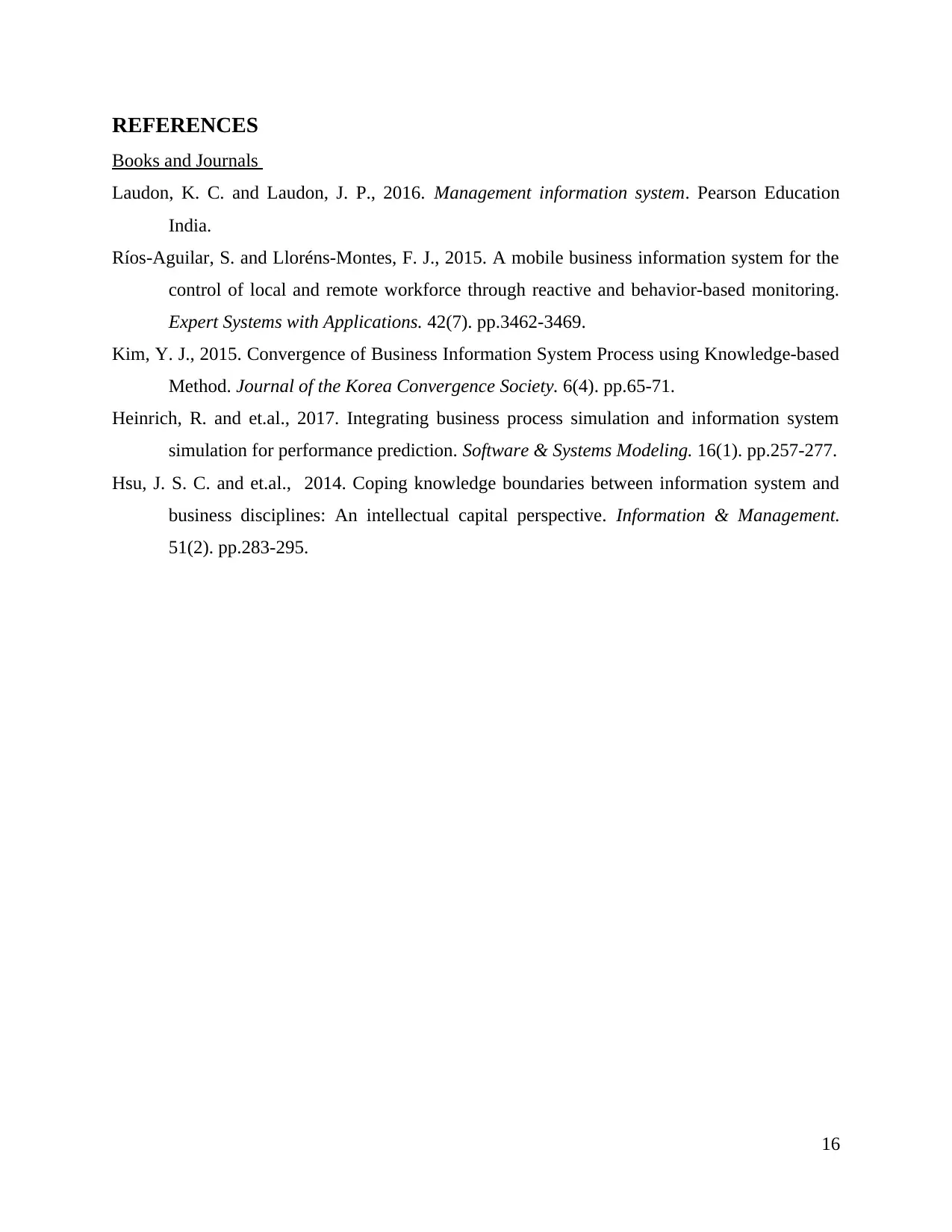
REFERENCES
Books and Journals
Laudon, K. C. and Laudon, J. P., 2016. Management information system. Pearson Education
India.
Ríos-Aguilar, S. and Lloréns-Montes, F. J., 2015. A mobile business information system for the
control of local and remote workforce through reactive and behavior-based monitoring.
Expert Systems with Applications. 42(7). pp.3462-3469.
Kim, Y. J., 2015. Convergence of Business Information System Process using Knowledge-based
Method. Journal of the Korea Convergence Society. 6(4). pp.65-71.
Heinrich, R. and et.al., 2017. Integrating business process simulation and information system
simulation for performance prediction. Software & Systems Modeling. 16(1). pp.257-277.
Hsu, J. S. C. and et.al., 2014. Coping knowledge boundaries between information system and
business disciplines: An intellectual capital perspective. Information & Management.
51(2). pp.283-295.
16
Books and Journals
Laudon, K. C. and Laudon, J. P., 2016. Management information system. Pearson Education
India.
Ríos-Aguilar, S. and Lloréns-Montes, F. J., 2015. A mobile business information system for the
control of local and remote workforce through reactive and behavior-based monitoring.
Expert Systems with Applications. 42(7). pp.3462-3469.
Kim, Y. J., 2015. Convergence of Business Information System Process using Knowledge-based
Method. Journal of the Korea Convergence Society. 6(4). pp.65-71.
Heinrich, R. and et.al., 2017. Integrating business process simulation and information system
simulation for performance prediction. Software & Systems Modeling. 16(1). pp.257-277.
Hsu, J. S. C. and et.al., 2014. Coping knowledge boundaries between information system and
business disciplines: An intellectual capital perspective. Information & Management.
51(2). pp.283-295.
16
1 out of 19
Related Documents
Your All-in-One AI-Powered Toolkit for Academic Success.
+13062052269
info@desklib.com
Available 24*7 on WhatsApp / Email
![[object Object]](/_next/static/media/star-bottom.7253800d.svg)
Unlock your academic potential
© 2024 | Zucol Services PVT LTD | All rights reserved.





